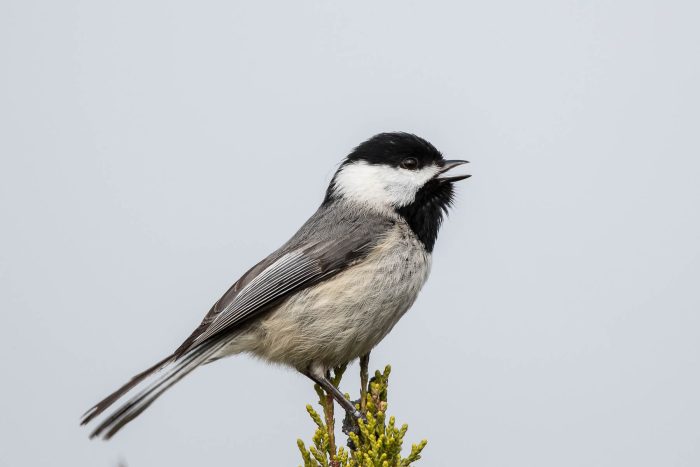Carolina Chickadee
Poecile carolinensis
The Carolina chickadee is a small, plump songbird that lives in wooded areas, including parks and backyards, throughout the southern half of the Chesapeake Bay watershed.
This section shows one large critter image at a time. Use the thumbnails that follow to select a specific image to display here.

This gallery contains a grid of small thumbnails. Selecting a thumbnail will change the main image in the preceding section.
Appearance
The Carolina chickadee grows to about 4.5 inches in length. It has a small, plump body with a short neck and a large head. It has white cheeks; a short, dark bill; and a black "cap" and "bib." Its back, wings and tail are a dark gray color, while its belly is whitish, often with buff-colored sides.
Feeding
The Carolina chickadee feeds mostly on insects and spiders, but will also eat seeds and berries, especially in winter. They can often be seen at bird feeders in winter. It is acrobatic while feeding: chickadees hang upside down and tilt their head and body up to reach insects on leaves and tree bark. In winter, they live in small flocks of 2 to 8 chickadees to create a feeding territory, which they will defend from other flocks.
Predators
Wrens, woodpeckers, raccoons, opossums, flying squirrels, rat snakes and domestic cats all prey upon chickadee eggs and young. Hawks prey upon adult chickadees.
Voice
The chickadee makes a four-note call, see-dee, see-dee, or a buzzy chickadee-dee-dee-dee.
Reproduction and life cycle
Pairing begins in winter. Some pairs may only stay together for a single season, but it appears that most chickadee pairs mate for life. Pairs find or construct a cavity within a dead tree or tree limb. Then the female builds a nest of moss, feathers and plant detritus (dead organic material) in the cavity. Chickadees will also nest in bird houses. The female lays 3 to 10 eggs, which are incubated for about two weeks. Young fledge about 16 to 19 days after hatching, and become independent 2 to 3 weeks after fledging.
Did you know?
- Carolina chickadees are the smallest chickadee in North America.
- In winter, when temperatures drop, chickadees survive by holing themselves in a small cavity and lowering their body temperature to the point of hypothermia. They can stay this way for up to 15 hours.
- Carolina chickadees appear nearly identical to black-capped chickadees at first glance. Black-capped chickadees have brighter, more-contrasted coloring and are slightly larger than Carolina chickadees.
Sources and additional information
- Animal Diversity Web: Poecile carolinensis – University of Michigan Museum of Zoology
- All About Birds: Carolina Chickadee – The Cornell Lab of Ornithology
